
Srila Raghunath das Goswami, is one of the six revered goswamis of Vrindavana. His renunciation and love for the supreme, is glorified all over the three worlds. Just as Srila Sanatana Goswami and Srila Rupa Goswami are known as the Sambandha and the Abhidheya acharyas, Srila Raghunath Das Goswami is referred to as the Prayojana (achieving the love of God) acharya of our sampradaya, as he had revealed ,the divine service of Srimati Radharani to be the topmost spiritual perfection. He was born 500 years ago, here at Krishnapur, a small village situated in Bandel, in the Hooghly district of West Bengal. Krishnapur back then was one of the seven villages constituting Saptagram (present day Adisaptagram). His birth and pastimes at Saptagram are a matter of great pride for us Bengalis. Sri Kavi karnapura reveals in Gaura Ganoddesha Dipika that Srila Raghunath das was the combined incarnation of the potencies of Rati Manjari, Rasa manjari and Bhanumati devi.
His love for the Supreme was so intense that Sri Radha and Krishna used to take a break from their eternal pastimes to shower their special mercy upon him. For instance when Sri Raghunath was once busy chanting his rounds ,sitting on the banks of Radha Kunda, Sri Syamasundara had Himself appeared with a stick, to protect him from the tigers who had gathered there for drinking water. Radha Kunda back then was surrounded by a jungle full of carnivorous animals.On another occasion, Srimati Radharani provided Raghunath Das with the cooling shades of Her saree’s end (aanchal), while he was busy chanting his rounds in a hot summer afternoon. She stood there perspiring profusely. Observing these sweet pastimes ,Sri Sanatana Goswami later suggested Raghunath Das to construct a bhajana kutira on the banks of Radha Kunda and chant staying inside, so that the divine couple do not have to appear again and again in order to protect him.
Srila Raghunath das Goswami used to daily chant 64 rounds on his beads (100,000 holy names). He used to offer 1000 obeisances unto Krishna and 2000 obeisances unto the vaishnavas everyday. He used to daily recite the pastimes of Lord Caitanya that he had witnessed staying with the Lord at Jagannatha Puri or had heard them from Svarupa Damodara, Mahaprabhu’s personal assistant.Srila Krishnadasa Kaviraja Goswami was his sincere student and these classes had later helped Krishnadasa compose the glorious ‘Caitanya Caritamrta’. ‘The Gaudiya Treasures of Bengal’ has covered the pastimes of Krishnadasa Kaviraja in a separate article entitled – ‘Jhamatpura (Near Katwa) – Residence of Srila Krishnadasa Kaviraja Goswami’. Sri Raghunath rested for only ninety minutes everyday and some days, he didn’t take any rest at all. He honored only one leaf cup of buttermilk which served as his meal for the entire day. He exhibited the highest standards of renunciation and exhibited the esoteric method of engaging oneself in the service of the divine couple.
Early Life of Raghunath das Goswami :
Srila Raghunath was born in a family of vaishnavas in the year 1494 AD.His father Sri Govardhan majumdar, was a wealthy landowner here at Krishnapur. The title majumdar was granted upon them by the erstwhile king and their yearly income ,after paying their taxes, exceeded 2 million in those days. The members of the Majumdar family were devout vaishnavas, and served Sri Caitanya Mahaprabhu’s mission in whatever ways possible.
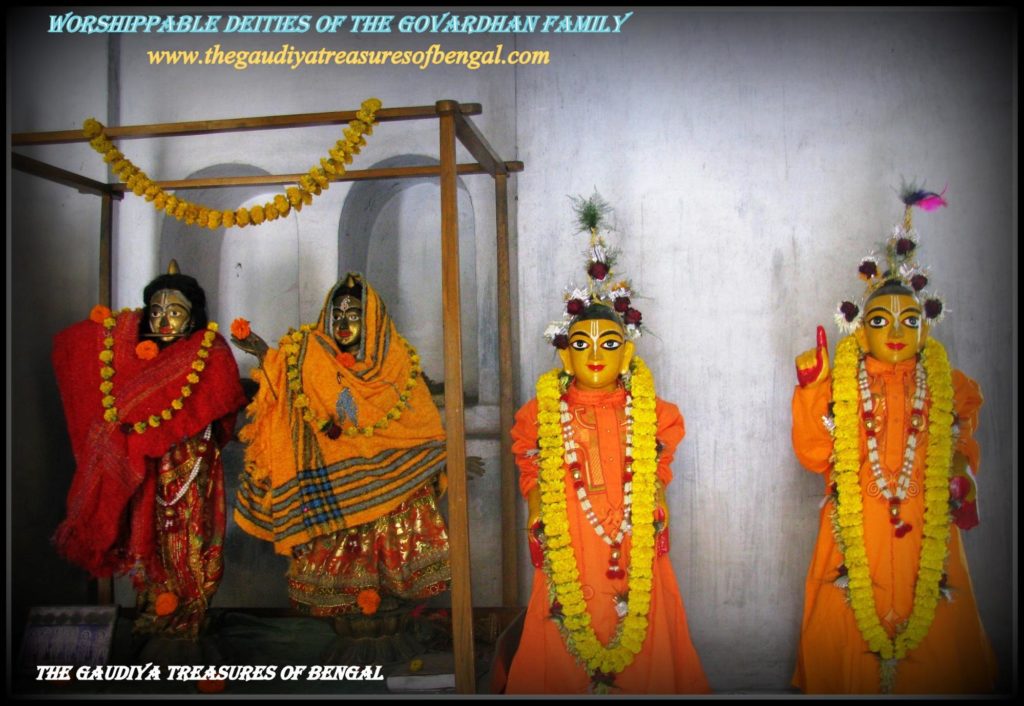
Srila Raghunath Das was fortunate in his childhood to receive the association of stalwart Vaishnavas like Sri Yadunandana acharya (a disciple of Advaita Prabhu), Balarama Acharya (who was also their family priest), etc. Namacharya Srila Haridasa Thakura had resided for some days at a place not very far from Raghunath’s residence. During this time, little Raghunath received the mercy of this great saint as well. Srila Krishnadasa remarks in Caitanya Caritamrta, that it was as a result of his association with Haridasa Thakura, that Raghunath Das could later meet with Lord Caitanya. ‘The Gaudiya Treasures of Bengal’ has covered the pastimes of Haridasa Thakura in a separate article entitled – ‘Sri Haridasa Thakura’s Bhajana Kutira, Phulia’.
Raghunath das Goswami meets with Caitanya Mahaprabhu :
Raghunath Das, ever since his childhood, was not attached to wealth or family life.From the very beginning, he had developed a keen desire to meet and surrender himself unto Lord Caitanya. In fact he was the first of the six Goswamis to have met Caitanya Mahaprabhu. When he was just fifteen years old, he obtained darsana of the Lord when He had arrived at Santipur. The Lord was then staying at the residence of Advaita Acharya. The Lord had already accepted His sannyasa initiation by then. ‘The Gaudiya treasures of Bengal’ has covered the sannyasa initiation pastimes of the Lord in a separate article entitled – ‘Sri Gauranga Bari (katwa) – Where Mahaprabhu accepted Sannyasa’. Seeing the Lord, little Raghunath immediately fell down at His lotus feet and seeked His blessings.
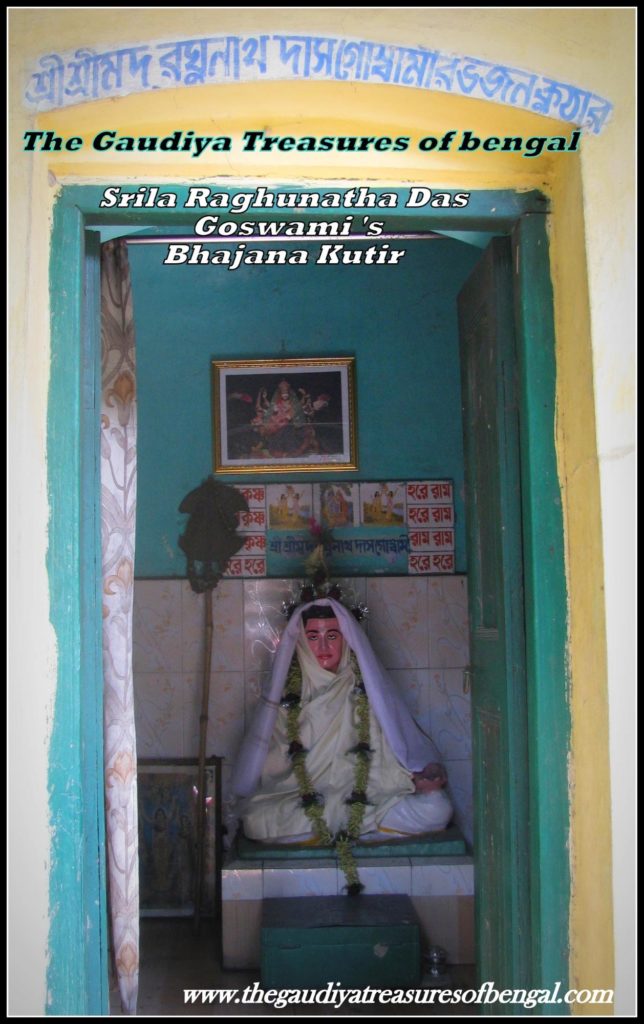
Srila Raghunath Das would often run away from his home, so that he could go to Jagannatha Puri and take shelter of Lord Caitanya.But his parents would somehow find him and bring him back to his home forcibly .Things gradually became so worse, that Raghunath Das was always watched upon by his father’s guards in order to keep him from running away.Though his parents were also vaishnavas, yet they were attached to their material life. They desired that their son would continue executing his worldly duties along with serving Mahaprabhu’s mission. But Raghunath Das had other intentions and was destined to dedicate his life solely in the service of Lord Gaurahari.
Four years on, Mahaprabhu and Raghunath met once more. This time the Lord had advented to Santipur after completing His tour of south India. Hearing of the Lord’s arrival, Raghunatha could not be contained anymore.Taking the permission from his reluctant parents, he rushed to meet the Lord.He surrendered himself unto His lotus feet and expressed his keen desire to renounce family life completely. He wanted to accompany the Lord and stay with Him at Puri.
Difference between Markata Vairagya and Yukta Vairagya:
Lord Caitanya ,however, refused to take Raghunatha das, and sent him back to his home. He advised him to be patient and not to behave like a crazy person. Lord Caitanya instructed him not to become a show-bottle renunciate (markata vairagi) and instead have faith upon Krishna and continue to deal normally with the outside world like an ordinary person.Mahaprabhu revealed to Raghunatha, that in this way, Krishna shall become very pleased with him and soon deliver him from the clutches of maya.
Markata vairagya na koro loka dekhana
Yatha yogya visaya bhunja anashakta hana
antare nistha kara, bahye loka vyavahara
acirata Krishna tomaya karibe uddhara
(cc, madhya, 16.238-239)
Srila Prabhupada here translates ‘markata vairagya’ as false renunciation.Srila Bhaktisiddhanta Saraswati Thakura compares markata vairagya to the renunciation of the monkeys. By artificial examination, one might conclude the monkeys to be highly renounced as they don’t wear any clothes,and roam about naked in the forests.However, a closer observation reveals that they are always busy enjoying their senses and indulging in sex with their female counterparts. Such a hypocrisy is the philosophy of a false renunciate. So Sri Caitanya mahaprabhu here rejects and warns against such show-bottle renunciation.
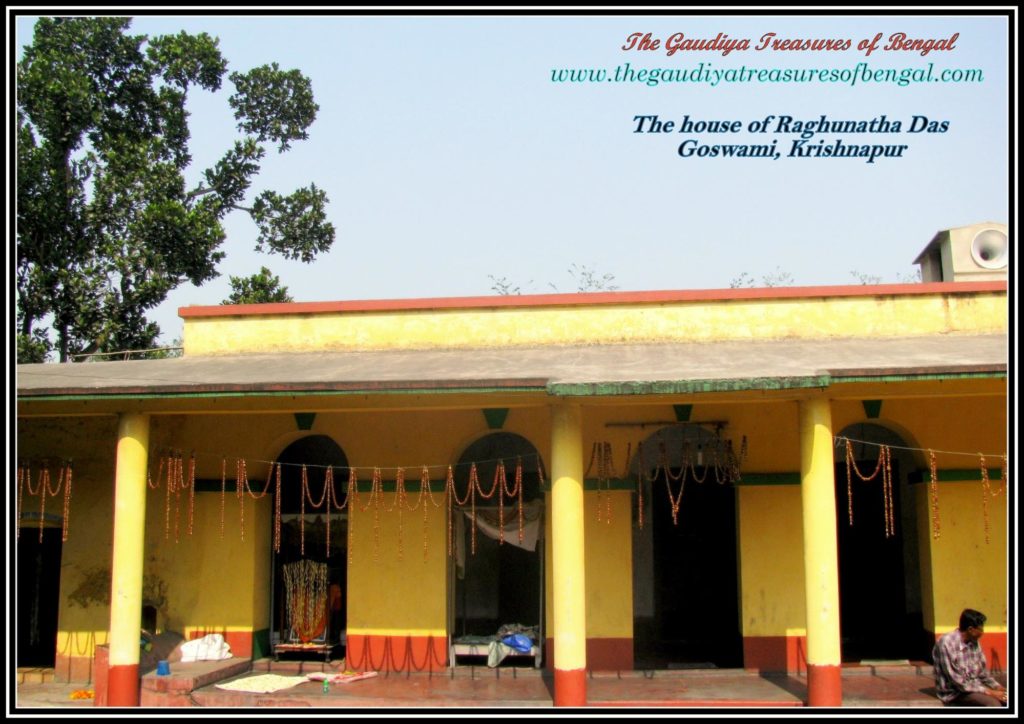
Instead Lord Caitanya propounds the path of Yukta-vairagya or befitting renunciation, wherein one doesn’t necessarily have to leave his house or start living in a forest to practice Bhakti. Such a person would readily accept anything that can be engaged in the service of Sri Guru and Krishna. Similarly he would reject anything that is unfavourable for serving Sri Guru and Krishna.In other words, all his activities are entirely geared for pleasing the Supreme. Such a person is very dear to Sri Krishna.Sri Caitanya here instructs Raghunatha Das to try to become a yukta-vairagi instead of renouncing the external world altogether.
Taking Lord Caitanya’s instructions to his heart, Srila Raghunatha became pacified and returned back.In due course of time he got married to a very beautiful lady, and his parents were very happy seeing Raghunatha take interest in worldly affairs.But internally, Raghunatha was always contemplating upon the lotus feet of Sri Caitanya and longed to receive His association very soon.
Hiranya and Govardhan Majumdar’s tax problems:
There is a very interesting pastime that had taken place while Raghunatha Das Goswami was still residing at Krishnapur. Once the tax collector of the erstwhile Muslim Government, had found certain discrepancies with the taxes submitted by Raghunatha’s father and uncle, Govardhan and Hiranya majumdar.This tax collector, who happened to be Turkish by origin, charged them with tax fraud. Not finding the two brothers however, this chowdhury (government official) put Raghunatha in jail.Everyday he would plan to beat Raghunatha to interrogate the whereabouts of his father and uncle, but seeing his innocent face and gentle nature, he would not be able to do so.Observing this, Raghunatha decided to play a trick with him.While the tax collector was visiting him one day, he started crying. On being asked for the reason, he replied that the Turkish chowdhury was just like his uncle. By this relation his father and uncle were like the Chowdhury’s own brothers and Raghunatha was like his own son. The Chowdhury became even more emotional when Raghunatha asked as to how he could even think of torturing his own son. Raghunatha greatly praised him as a noble muslim who was well versed in Islamic scriptures.

The Turkish Chowdhury began crying. Feeling compassionate, he at once released Raghunatha.He also told him that his father and uncle need not fear him anymore, and that they can do away with all their financial irregularities by just sharing with him a small portion of their unaccounted money. In this way Raghunatha saved Govardhan and Hiranya Majumdar from a grave danger.
Panihati Dahi-Chida festival
‘The Gaudiya Treasures of Bengal’ has narrated the pastimes of dahi-chida festival in great detail in the article entitled – ‘Raghava Bhavan, Panihati’. We would quickly like to summarize the pastime here as well.When Nityananda Prabhu and His associates returned to bengal (from Puri), they became guests at the house of Raghava pandita. Staying here at Raghava Bhavana, they manifested their awe inspiring pastimes continuously for three months. A grand sankirtana took place here, in which Lord Nitai, His associates as well as the local villagers participated. Being overwhelmed with ecstatic love for the Lord, the devotees laughed, cried and rolled over the ground, being completely oblivious of their external consciousness. As the sankirtana gathered mood, the devotees began displaying their supernatural powers like lifting up trees with their hands and jumping from one place to the other defying gravity. By dint of their spiritual prowess, they could go on with almost no food and water for entire three months. Whichever direction Lord Nitai would glance, he would shower ecstatic Krishna prema without any consideration, receiving which the devotees would at once fall down unconscious.
It was here at Panihati, on the bank of the Ganges, that Raghunatha Das Goswami had received the causeless mercy of Sri Nityananda Prabhu. Hearing the news of Lord Nitai’s arrival, Sri Raghunatha Das wanted to meet and seek His blessings. His father reluctantly agreed as he feared that his son would again run away from his home. Being properly protected with guards, Sri Raghunatha arrived at panihati.
Seeing Lord Nitai, Raghunatha Das offered his obeisances from a distance. Observing this, Nityananda prabhu asked Raghunatha as to why he was standing so far. Actually Raghunatha Das considered himself too contaminated and too materialistic to even approach Him. Nityananda prabhu called Raghunatha near, and touched His lotus feet upon his head ,and thereby blessed him. Raghunatha prayed to Lord Nitai to bless him so that he could soon be released from the bondage of family life and surrender fully unto the lotus feet of Lord Caitanya.Nityananda prabhu blessed Raghunatha, that his desire shall soon be fulfilled and also blessed him that he shall soon be renowned as one of the most intimate associates of Lord Gaurahari. Lord Nitai requested all of His associates to bless Raghunatha das.
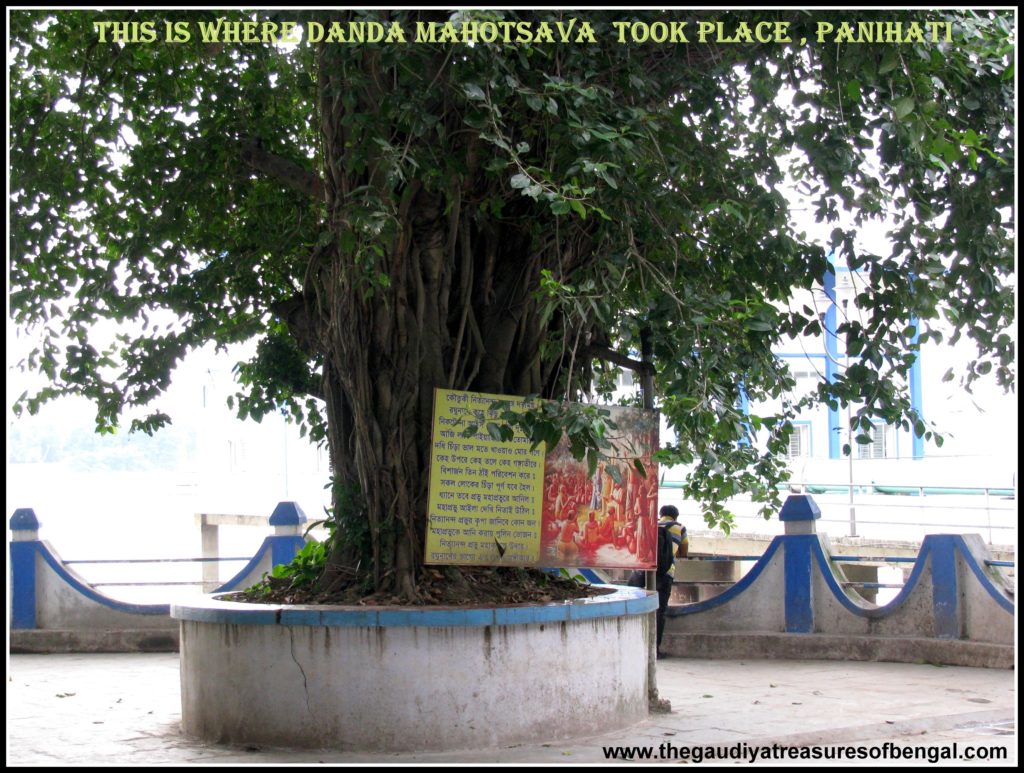
Nityananda Prabhu then desired that Raghunatha Das, being a rich man’s son, should feed all of His associates dahi-chida (curd and chipped rice) sumptuously.Lord Nitai joked that Raghunatha, who was praying from a distance like a thief had now been captured, and so he had received this Danda (punishment). Raghunatha became very happy to hear this and immediately made the necessary arrangements to feed all the vaishnavas sumptuously. All the intimate associates of Nityananda Prabhu namely Uddharana datta Thakura, Gaudidasa Pandita, Gadadhara das, Murari Caitanya, etc were present.It is said that not only Lord Nitai and His associates but all the local devotees honoured the delicacy to their full content.There were so many devotees, that all of them could not be accommodated on the bank of the ganges; hence many devotees, went and stood inside the river submerging themselves up to their necks to attend the sumptuous feast. Lord Nityananda was so happy with the arrangement that He meditated upon Sri Caitanya, who immediately appeared over there in His transcendental form. Thereafter the two Lords went over to each and every clay pot and taking a morsel of chipped rice from each pot ,put it into the other’s mouth. Such was the loving reciprocation they enjoyed.This is how the great Dahi-Chida festival (sometimes also referred to as the Danda-mahotsava) came into being and the Gaudiya vaishnava devotees from all over the world gather even today at Panihati to commemorate this occasion every year.‘The Gaudiya Treasures of Bengal’ considers itself immensely fortunate to have been able to attend the same a few years back. Srila Raghunath Das Goswami’s beloved Radha Ramana jiu deities are worshipped till this day at Raghava Bhavan.
It is also very important to note at this point, that without the mercy of Nityananda Prabhu, it is not possible for one to gain the shelter of Lord Caitanya (as we see in the case of Raghunath das Goswami). Hence it is very important for us to aspire the cooling shades of Lord Nitai’s lotus feet to make any significant progress in our spiritual lives.
Nitai pada kamala, koti candra sushitala
je chhayay jagata juray
heno Nitai bine bhai, radha krishna paite naai
dridha kori dharo nitai-er paay
-Locana Das Thakura
Raghunath das Goswami escapes from Krishnapur:
Though Srila Raghunatha Das behaved externally as a materialist, yet internally he always contemplated on how he could escape and reunite with his beloved Gauranga. So one night the opportunity presented itself to him. Yadunandana, the family Guru, called Raghunatha in the middle of the night and requested him to pacify one of the priests who had decided to leave his service.He wanted Raghunatha to somehow convince the priest to stay and continue the service of the deities. He had asked Raghunatha to talk to the priest as Raghunatha was an expert in dealings. Raghunatha understood that this was his chance to escape and he grabbed it with both hands. After Yadunandana went out of sight, he fled on foot. He initially ran exactly in the opposite direction to Puri (he ran east), as he feared that the search party would find him otherwise. Then he changed his direction and travelled through the jungles. Though his parents searched for him all over, yet they could not find him. Reaching Puri on the twelfth day, he surrendered unto the lotus feet of Gaurahari.Lord Caitanya embraced him and entrusted him unto the care of Svarupa Damodara, His personal secretary.
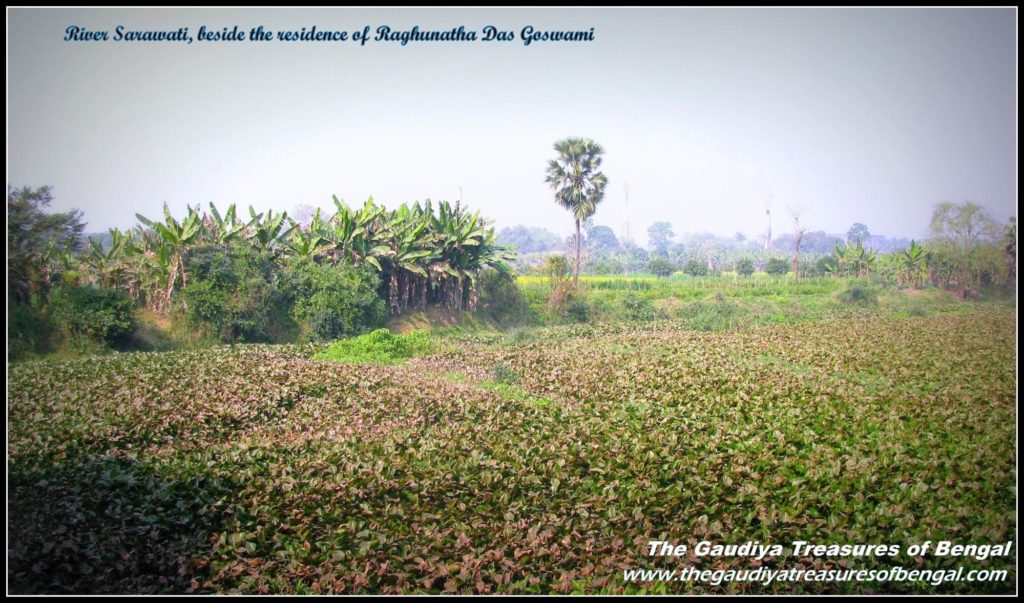
Gradually Srila Raghunatha Das Goswami began exhibiting the highest standards of renunciation, which greatly pleased Mahaprabhu. Wearing the Lord’s instructions of ‘trinad api sunicena, taror api sahishnuna’ around his neck, Srila Raghunatha, the son of a rich landlord, now begged for his food sitting in front of the main gate (simha dvara) at Jagannatha Puri. He was devoid of any false prestige. After a few days, he stopped sitting at simha Dvara, and began eating at the free Prasadam booths. As the nectar of renunciation further increased, Raghunatha Das Goswami, stopped accepting prasadam even at the free booths. Now he collected all the Mahaprasadam that were not sold anywhere and which were eventually thrown away into the pile. The Mahaprasadam he collected, usually became very rotten and was rejected even by the animals. He used to take them to his home and there wash them very carefully. Then he would peel the outer rotten portion, and eat the inner part applying salt on it. Once Lord Caitanya came to the residence of Raghunatha das Goswami and by forcibly taking some of this Mahaprasadam, tasted it. He remarked that this was the most nectarian prasada He had ever had. Actually though the prasada was rotten, Srila Raghunatha’s humility and devotion greatly pleased Mahaprabhu. Lord Caitanya gifted His own worshipable Govardhan Sila and Gunjamala to Raghunatha das Goswami. Srila Krishnadasa kaviraja explains in Caitanya Caritamrta that renunciation is the basic principle sustaining the lives of Mahaprabhu’s followers and this spirit of renunciation greatly pleases Sri Gaurasundara (Mahaprabhu-ra bhakta ganera vairagya pradhana, yaha dekhi prita hana Gaura bhagavana).
It is worthwhile mentioning over here at this point, that it is not possible for most of us to imitate the high standards of austerity and renunciation exhibited by Raghunatha Das. Neither should we try to imitate his behaviour for name and fame. Instead we should try to learn and seek inspiration on how one should honor and respect Mahaprasadam, realizing it to be the remnants of the Supreme Lord.
Raghunatha Das stayed at Jagannatha Puri for sixteen years. After Lord Caitanya had wrapped His earthly pastimes, Sri Raghunatha das greatly suffered the pangs of separation from his beloved Lord. Sri Svarupa Damodara had also disappeared soon thereafter. Raghunatha felt as if he could no longer maintain his life and thus decided to commit suicide jumping from the top of the Govardhana hill. When he arrived at vrindavana for this purpose, he met Rupa and Sanatana Goswamis, who pacified him and persuaded him to continue with his life. Treating him like their own brother, they kept him with them.All the devotees of Vrindavana including Rupa, sanatana, Krishnadasa Kaviraja, etc were enriched by hearing the nectarian pastimes of Lord Caitanya as narrated by Raghunatha. Infact most of Lord Gaurahari’s heart-melting pastimes that we read in the Caitanya caritamrta today, was actually learnt by Krishnadasa from these lectures of Srila Raghunatha. Srila Raghunatha’s life of extreme austerity and renunciation continued in Vrindavana as well. Hardly eating anything, he incessantly kept chanting the holy names of Sri Krishna. He slept for only one and half hours daily. He bathed thrice at radha Kunda and chanted the holy names 100,000 times a day. We have already previously described how Sri Radha and Krishna used to take a break from their eternal pastimes to shower their special mercy upon him.
‘The Gaudiya Treasures of Bengal’ has been striving to seek shelter of such great personalities throughout its spiritual journey. It is only with this objective of receiving their mercy and sharing it with others, that we have set out from our homes, trying to reveal to the world the mood and esoteric pastimes of these great men.The life and teachings, of these stalwarts inspire us to imbibe the same values and principles in our own lives and we pray that they mercifully bless us, so that we may forever contemplate upon their blissful pastimes.Sri Raghunatha Das Goswami wrapped up his earthly pastimes, in the year 1586 AD in the shukla dwadashi tithi of Ashvin (september-october). His samadhi tomb and bhajana Kutira continues to stand on the banks of Radha Kunda till this day.
Srila Gaura Kishor Das Babaji maharaj , one of the revered acharyas of our sampradaya, encapsulates the mood and ecstasy of Srila Raghunatha das Goswami in one of his bhajanas – ‘Kothaya Go Premamayi Radhe Radhe’.Here he points out how Sri Raghunatha Das was constantly seeking the shelter of Srimati Radharani, how he was incessantly crying tears of love being intoxicated in the mood of servitude to Vrindavaneshwari.The bhajana describes how Sri Raghunatha das used to roll about in the dust of vraja from kesi ghat to vamsi vata,from nidhuvana to kusja vana, Radha kunda and Syama kunda, seeking the merciful glance of Sri Radhika. We are posting below this bhajana for the pleasure of the devotees.We are not posting the english translation,however, to avoid making this article lengthy. One desiring to read the translation may refer to the vaishnava song book. However, those who understand bengali, could hopefully relish this wonderful piece directly.
(1)
kothaya go premamayi radhe radhe
radhe radhe go, jaya radhe radhe
(2)
dekha diye prana rakha, radhe radhe
tomara kangala tomaya daake, radhe radhe
(3)
radhe vrindavana vilasini, radhe radhe
radhe kanu-mana-mohini, radhe radhe
(4)
radhe asta-sakhira siromani, radhe radhe
radhe vrishabhanu-nandini, radhe radhe
(gosai) niyama kare sadai dake, radhe radhe
(5)
(gosai) eka-bara dake kesi-ghate,
abara dake vamsi vate, radhe radhe
(gosai) eka-bara dake nidhu-vane,
abara dake kusja-vane, radhe radhe
(6)
(gosai) eka-bara dake radha-kunde,
abara dake syama-kunde, radhe radhe
(gosai) eka-bara dake kusuma-vane,
abara dake govardhane, radhe radhe
(7)
(gosai) eka-bara dake tala-vane,
abara dake tamala-vane, radhe radhe
(gosai) malina vasana diye gaya,
vrajera dhulaya gadagadi jaya, radhe radhe
(8)
(gosai) mukhe radha radha bale,
bhashe nayanera jole, radhe radhe
(gosai) vrindavane kuli kuli kede bedaya
radha bali, radhe radhe
(9)
(gosai) chhappana danda ratri-dine
jane na radha-govinda vine, radhe radhe
(10)
tara para cari danda suti thake
swapane radha-govinda dekhe, radhe radhe
What to See at Krishnapur Thakurbari
The grandeur and opulence of the erstwhile Govardhan family can be still felt, here at Krishnapur. The worshipable deities of the Govardhan family, and which have been previously worshipped by Sri Raghunatha Das as well, are still served here at the Thakurbari. One visiting this place can take darsana of these beautiful deities and smear himself with the dust of this place which has been sanctified by the impressions of the lotus feet of the great Raghunatha Das gosai. The bhajana kutira of our beloved Gosai is also still preserved here at the thakurbari.
We worship the lotus feet of our spiritual master ,whose causeless mercy has empowered us ineligible fools ,to gain entrance and take up service in this exalted abode of Krishnapur. We seek shelter of this holy land, and pray that its glories remain forever imprinted in our heart.‘The Gaudiya Treasures of Bengal’ offers millions of obeisances and humbly prays to Sri Raghunatha Das Goswami that we advance in our Krishna consciousness, develop attachment unto the lotus feet of Lord Gauranga and are able to serve Sri Guru & Vaishnavas, by our honest and sincere efforts. We seek his blessings and compassion , in successfully rendering this humble service of reciting the pastimes and revealing the pastime places of the Supreme Lord and His beloved associates.We shall consider ourselves greatly fortunate and our existence meaningful if Lord Gaurahari and our dear spiritual master are kindly pleased with our endeavours.
How to Reach
The team from ‘The Gaudiya Treasures of Bengal’ drove all the way from kolkata to reach Krishnapur Thakurbari. This place is located near the Trishbigha railway station (near Adisaptagram) ,in the district of Hooghly. It is a 10 minutes drive from the residence of Sri Uddharana Datta Thakura. The place is locally renowned as Krishnapur Thakurbari. The once opulent town of saptagram, is now almost lying in ruins. We drove a further 10 minutes from Adisaptagram to reach Srila Raghunatha’s residence, here at Krishnapur.There was no proper road and we had to practically drive upon half cooked lanes.
Upon reaching there, we could at last find the once opulent house of the renowned landlord Sri Govardhan majumdar, who had the wealth to lease almost the entire town of Saptagram 500 years ago. The original house however is non-existent today, but the temple where the deities were worshipped (Thakur Dalan) back then, has been renovated and restored.The house is situated on the banks of river saraswati which is almost lying dry today. The worshipable Gaur-Nitai deities of the Majumdar family are still worshipped here at the Thakurbari and they are being served here today by a few fortunate souls who have dedicated their mind,body and words in the service of this sacred dham. The whole atmosphere is highly spiritually surcharged and the serene atmosphere on the bank of the river further adds to its charm. Apart from the worshipable Gaur-Nitai deities of the Govardhan family, an enchanting deity of Sri Radha Krishna is also served here today. The hairs on our bodies stood at their ends, contemplating on how our dear Gosai performed his childhood pastimes here, how he used to perform his ecstatic krishna bhajana, how he attempted to run away again and again and his parents brought him back to this place.
Accommodation – One can choose to stay in any of the prominent hotels near Bandel like hotel aquatic palace (on Kalyani expressway), etc. Krishnapur Thakurbari is hardly a 30 minutes ride from there. The devotees need to make prior arrangements of their own prasadam.
Nearest major airport – Netaji Subhash Chandra Bose International Airport (Kolkata)
Nearest major Railway station – Adisaptagram
(Please note that we neither necessarily recommend these hotels/accommodation centers mentioned above nor do we guarantee that they will provide the required facilities/services to the visiting pilgrims. We are not in any way related to the governance of these hotels/accommodation centers. The visiting pilgrim is advised to choose an accommodation as per his own discretion)
A brief history of Saptagram
Saptagram, as the name suggests, comprised of the following seven villages – Saptagram,bamsabati ,shibpur, vasudevapura, krishnapura , Nityanandapur and Sankhya Nagara. Saptagram find its mention even in the vedic scriptures as the sacred place where in the previous yugas the seven celestial sages had performed severe austerities in order to please the supreme Lord. Hence Saptagram has traditionally been an exalted site for pilgrimage. The three sacred rivers Ganga, Yamuna and Saraswati meet here at saptagram and their confluence is renowned as ‘Triveni’.The ‘Triveni Ghat’ (‘ghat’ means bank) is visible even today, and is said to have been later reconstructed by King Mukunda Deva of Orissa.The land of Saptagram has been eternally blessed by the ecstatic awe inspiring pastimes of Nityananda Prabhu and His beloved disciple Sri Uddharana datta Thakura.‘The Gaudiya Treasures of Bengal’ has covered the life and pastimes of Sri Uddharana Datta Thakura in a separate article entitled – ‘Sri Uddharana Datta Thakura Sripat, Adisaptagram (Near bandel)’. Saptagram is also renowned as the birthplace of Srila Raghunath Das Goswami, the son of the erstwhile rich landlord ,Sri Govardhan Majumdar. Srila Raghunath Das Goswami, on obtaining the mercy of Lord Nitai, went onto become one of the greatest renunciates of our Gaudiya sampradaya and one of the foremost Goswamis of Vrindavana. Not very far from here, is also the Sripat (residence) of another stalwart Vaishnava named Sri Jharu Thakura, who was a sweeper by profession.We have covered his pastimes in a separate article entitled – ‘Sri Jharu Thakura Sripat, near Bandel’.
Saptagram had a deep port in those days and several ships used to commute upon the Saraswati river, on whose banks the town had once flourished. The mercantile community used to conduct their businesses using these waterways which also had an outlet to the sea. The famous businessman of Bengal , ‘Chand Saudagar’ ,is also said to have used these routes for his trading.